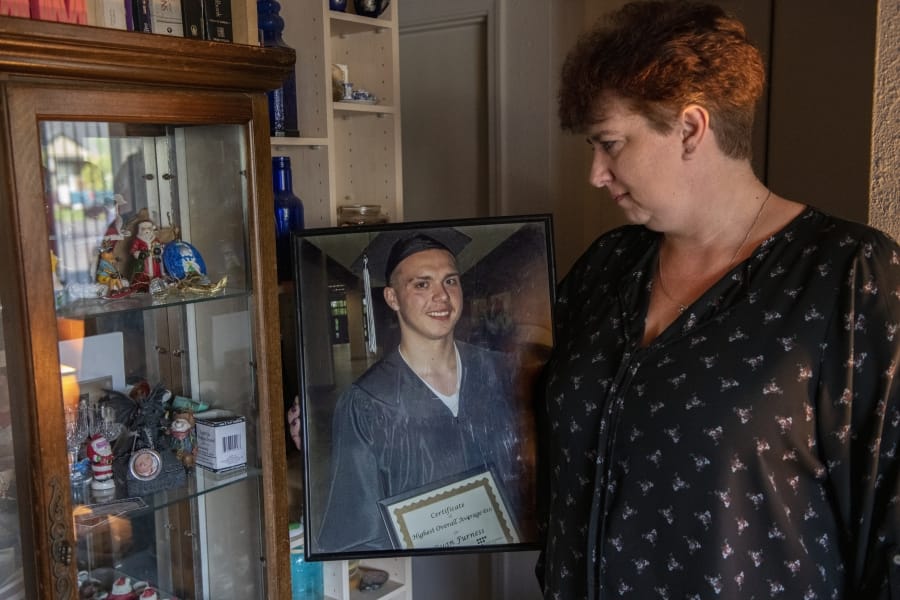Ryan Furness was funny and had a way with words.
He loved skateboarding and BMX biking. He cared about everyone. He once invited a friend in the foster care system over for Easter, his mother Lyn Anderson recalled.
“He couldn’t imagine someone else not enjoying family time,” Anderson said.
Furness was diagnosed with juvenile bipolar disorder before he turned 10. He started smoking marijuana around 13; alcohol use came about a year later. He was arrested for the first time around 14, and he started using heroin about three years later.
Even so, at 17 Furness was able to earn his GED diploma with Educational Service District 112’s GED program through Clark County’s Juvenile Justice Department. He was called back onstage at the end of the GED ceremony to be honored for having the highest math average of his class.
At 18, he received substance use treatment as an adult — he received treatment once as a minor, too — and went six months sober.
If You Go
When: 4 to 8 p.m. Saturday.
What: The event is open to everyone. There will be overdose-prevention training from 4 to 6 p.m. and a candlelight vigil from 6 to 8 p.m.
Where: Marshall Community Center, 1009 E. McLoughlin Blvd., Vancouver.
RSVP: You can RSVP for the overdose prevention training here: sw_wa_opioid_awareness_day_2019.eventbrite.com.
Contact: Jim Jensen, 360-409-3056 or jim.jensen@southwestach.org.
He had a partial scholarship to Clark College and was interested in construction work. He wanted a career with a state department like his grandfather, who spent 20 years in Oregon’s forestry service. But none of those things happened. Furness died of a heroin overdose on Aug. 19, 2012. His memorial was held six days later, on what would have been his 19th birthday.
“It’s still hard to know all he’s missing out on, and what he could have been, and the fact I know sobriety and recovery exists in long term,” Anderson said. “His relationship with me is — he’s still my ‘RyRy.’ ”
He’s also still moving his mother to continue advocacy work for overdose awareness and prevention. Along with Corey Sturdevant, Anderson co-founded the local Overdose Awareness Day event, which returns to Clark County for a third year Saturday, with overdose-prevention training and a candlelight vigil.
A limited supply of nasal Naloxone kits will be available at the event. Naloxone, or Narcan, is a medication that can be given in the midst of an opioid overdose and temporarily counters the effects of the overdose.
Beyond organizing the county’s overdose awareness event, Anderson is a program coordinator at Recovery Cafe Clark County; she also used to sit on the Southwest Washington Recovery Coalition before taking her job with Recovery Cafe.
There were more than 70,000 U.S. drug overdose deaths in 2017, which is about 30,000 more than the year Anderson’s son died, according to Centers for Disease Control and Prevention statistics.
Preliminary 2018 statistics indicate a drop in drug overdose deaths for the first time in nearly three decades, but it is still one of the 10 leading causes of death in the nation — there were 742 Washington residents who died from overdoses in 2017.
Anderson and others in the recovery community are working to convince people that overdose is a problem in which everyone should be invested. She admitted it can be hard to bring up overdose deaths in public. It’s not as easy as talking about your mother who died of cancer, or grandmother who died of lung disease, she said.
“You can be a normal kind of family and that people can still die from an overdose,” Anderson said. “It is very important to me, because a huge number of people are dying.”
Jim Jensen, a professor in Clark College’s Addiction Counselor Education Department and part of the Opioid Task Force, said overdoses are inexcusable. Opioid overdoses, by far the most common form of drug overdose, can be prevented if treated with Naloxone.
“There are tons of people dying all over Washington from opioid overdose and we can make an impact on that. There is a cure for overdose,” Jensen said in an interview in mid-June. “How do we care for those in the midst of addiction? How do we care for those still making bad choices? One of the ways we care for those folks is to not let them die in the darkness.”
Washington State Health Officer Dr. Kathy Lofy signed a standing order for Naloxone earlier this week, which allows any person or organization in the state to get Naloxone from a pharmacy, according to a state news release. The goal is to increase access to the life-saving medication. Jensen and Anderson wants more people trained to administer Naloxone.
“Everybody should be trained,” Anderson said of Naloxone. “If somebody had an allergic reaction to a bee, you’d know to find an EpiPen. If someone is having a heart attack, you’d want a defibrillator. If someone’s breathing is shut off because of the opioid, you want something to block that so you can breathe again. It makes sense. Everyone matters. They all deserve a chance.”




